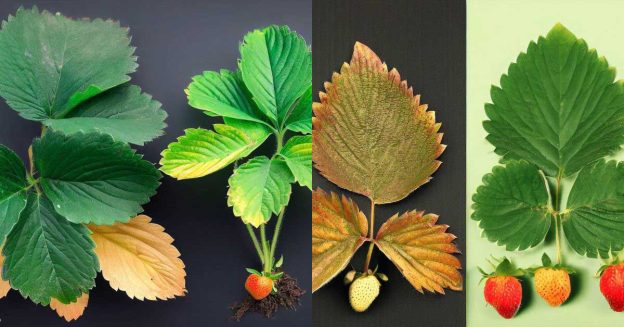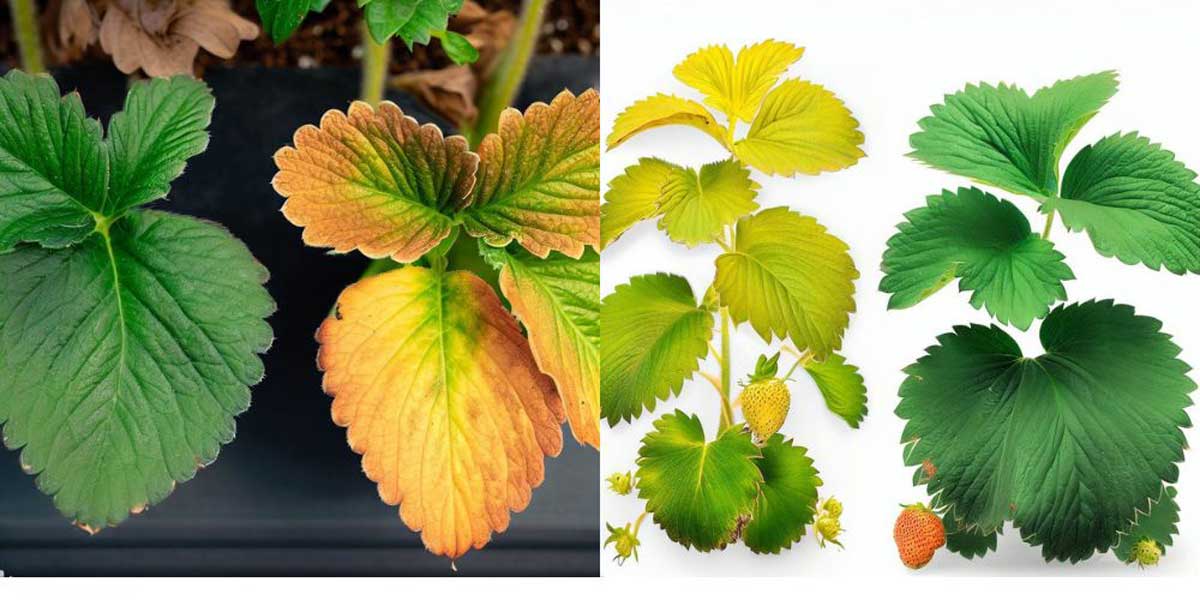To fix nitrogen deficiency in strawberry plants, use a balanced fertilizer with enough nitrogen, phosphorus, and potassium. You should use the fertilizer according to the soil test results and the recommendations of your local extension service. Generally, strawberries need about 1 pound of nitrogen per 100 square feet per year.
Strawberries, delightful fruits that thrive in gardens, demand attentive care and nourishment for optimal, bountiful harvests. Nitrogen is important for strawberries as it helps them grow, make leaves, do photosynthesis, and have good fruit. Lack of nitrogen in strawberries causes problems like small growth, yellow leaves, less fruit, and tasteless flavor.
Thus, it becomes crucial to identify the telltale signs of nitrogen deficiency and promptly address them to restore vitality.
Signs of Nitrogen Deficiency in Strawberry Plants
It can be identified by observing the color and shape of the leaves. The most common symptom of nitrogen deficiency is the yellowing of the lower leaves, especially the middle-aged ones. The yellow coloration starts from the edges and spreads to the center of the leaf blade, leaving only the veins green.
The leaves may also become smaller, thinner, and brittle. Older leaves can turn red or purple because of carbohydrates building up in the plant tissues.
Another sign of nitrogen deficiency is reduced plant size and vigor. The plants may appear stunted, with shorter runners and smaller leaf sizes. The fruiting calyx may also become red, and the petiole may develop a red cast. Lack of nitrogen can harm the strawberries’ quantity, size, shape, color, and taste, reducing their overall yield and quality.
Nitrogen Deficiency Causes in Strawberry Plants
There are several possible causes, such as:
- Inadequate supply of nitrogen in the soil.
- Soil pH is too high or too low.
- Too much manganese, chloride, zinc, or potassium in the ground.
- Excessive rainfall or irrigation can cause nitrogen to be washed away from the soil.
- Certain plants may have higher nitrogen requirements than others, which can lead to deficiencies if not properly managed.
How to Fix Nitrogen Deficiency in Strawberry Plants: A Complete Expert Guide
To fix nitrogen deficiency in berry plants, use a balanced fertilizer with enough nitrogen, phosphorus, and potassium. You should use the fertilizer according to the soil test results and the recommendations of your local extension service. Generally, strawberries need about 1 pound of nitrogen per 100 square feet per year¹. However, this amount may vary depending on the soil type, climate, variety, and growth stage.
The fertilizer should be applied in split doses throughout the growing season. The first application should be done before planting or at planting time². The second application should be made after flowering or when the first fruits start to form². The third application should be made after harvest or before dormancy².
You should apply the fertilizer evenly around the plants, while avoiding direct contact with the foliage or roots. The fertilizer should also be watered well after application.
Another way to fix nitrogen deficiency in strawberry plants is to use organic nitrogen sources, such as compost, manure, blood meal, fish meal, or alfalfa meal³. These sources can provide slow-release nitrogen to improve soil structure and fertility. However, they should also be used cautiously, as they may contain pathogens, weeds, salts, or heavy metals that can harm plants or humans. They should also be applied well before planting or harvesting to allow enough time for decomposition and mineralization.
How to Prevent Nitrogen Deficiency in Strawberry Plants
The best way to prevent nitrogen deficiency is to maintain healthy and fertile soil that can provide sufficient nutrients. It can be done by:
- Conducting a soil test before planting and every year after that to determine the soil pH and nutrient levels⁴
- Applying lime or sulfur if needed to adjust the soil pH to 5.5-6.5⁴
- Applying organic matter such as compost or mulch to improve the soil texture and water retention⁴
- Rotating crops with legumes or other nitrogen-fixing plants that can enrich the soil with nitrogen⁴
- Avoiding overwatering or underwatering that can leach or limit the availability of nitrogen⁴
- Avoiding excessive use of pesticides or herbicides that can damage the soil microorganisms or plant roots⁴
- Choosing varieties that are adapted to your climate and soil conditions⁴
People Also Ask (FAQs)
Q1: How do I know if my strawberry plants have enough nitrogen?
A: To check the nitrogen levels in your soil or plants, you can use a soil test kit or a tissue analysis. To check nitrogen levels in your soil or plants, you can use a soil test kit or a tissue analysis.
Additionally, you can observe the color and shape of the leaves, the size of the plant, and its strength. Healthy strawberry plants exhibit big, thick, dark green leaves. They also produce numerous runners and abundant fruit.
Healthy strawberry plants have big, thick, dark green leaves. They also have lots of runners and lots of fruit.
Q2: How much nitrogen do strawberry plants need?
A: The nitrogen requirements of strawberry plants vary based on soil type, climate, variety, and growth stage.
Q3: When should I apply nitrogen fertilizer to my strawberry plants?
A: You should apply nitrogen fertilizer to your strawberry plants in split doses throughout the growing season. The first application should be done before planting or at planting time. The second application should be done after flowering or when the first fruits form. The third application should be done after harvest or before dormancy.
Q4: What kind of nitrogen fertilizer should I use for my strawberry trees?
A: To ensure healthy plants, use a balanced fertilizer with nitrogen, phosphorus, and potassium. You can use organic sources such as compost or manure. However, you need to be cautious about the potential harm caused by pathogens, weeds, salts, or heavy metals. Apply organic sources well in advance for best results
Q5: How can I prevent nitrogen deficiency in my strawberry plants?
A: To prevent nitrogen deficiency in plants, maintain healthy soil by testing pH, adding organic matter, and rotating crops.
Conclusion
A lack of nitrogen in strawberries can harm their growth and productivity. It’s important to identify the signs, reasons, and remedies for this issue and take the necessary steps to resolve it. This way, you can have tasty and nutritious strawberries in your garden.
I am Gaushoul Agam
𝐂𝐨-𝐅𝐨𝐮𝐧𝐝𝐞𝐫 & 𝐂𝐄𝐎
ToAgriculture
I am an experienced Horticulture Officer in the Department of Agricultural Extension in Bangladesh. I am committed to improving agriculture and farming.
I created ToAgriculture to address global food safety concerns. These concerns are caused by a growing population, diminishing farmland, and the impact of climate change on agriculture. I assist readers in learning modern farming techniques.
I also help them control pests and diseases. Additionally, I guide managing agriculture sustainably. All of this is aimed at creating a better and more successful future in farming.
I have experience in field crops and horticulture crops. I know about fruit and vegetable farming, managing pests and diseases, irrigation, and grafting. Come with me as I share my knowledge and experiences to help you create a better future.

